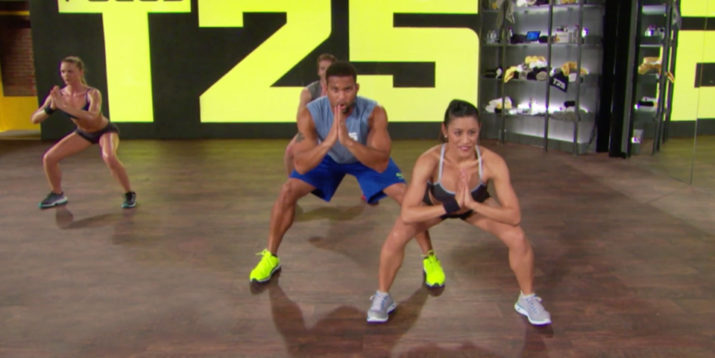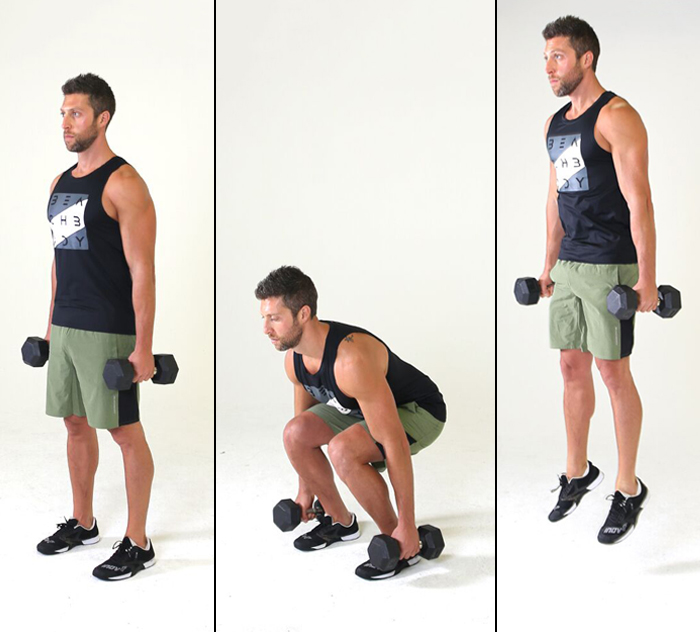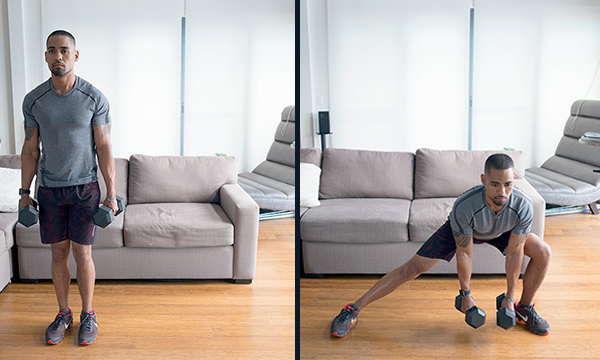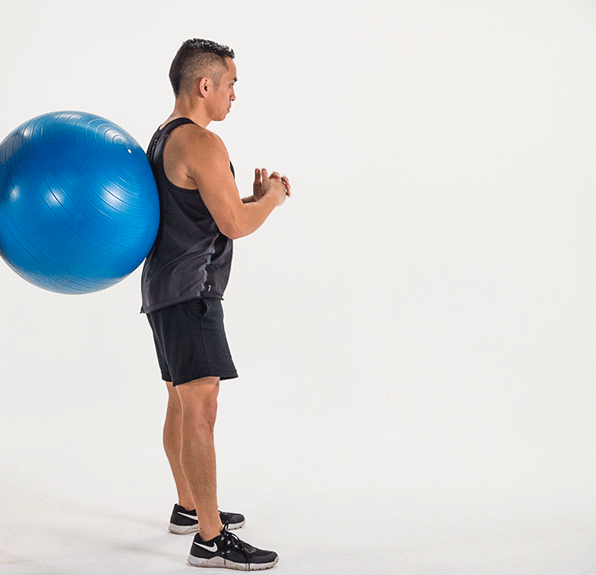How to Do a Proper Squat, Plus 11 Squat Variations to Try

If you want to strengthen your legs, build your butt, and work nearly every muscle in your lower body, look no further than the squat.
This seemingly simple move is a staple in most strength programs because it effectively works multiple muscles at the same time, including your quads, glutes, and even your core.
In fact, few other moves fire up more muscle than squats, which is one of the reasons why it’s known as one of the “big three” exercises (along with the deadlift and bench press).
But you need to know how to do a proper squat for it to be effective.
To get the most out of this muscle-building, fat-burning move, follow our pointers below on how to do squats with perfect form.
And to really get all the benefits of squats, mix things up by swapping out the basic bodyweight squat for one of our 11 favorite squat variations, many of which can be found in workout programs on BODi.
How to Do a Proper Squat
Before you load up your squats with weights, master the bodyweight squat. Here’s how to do squats properly:
- Stand tall with your hands by your sides, feet shoulder-width apart, and toes pointed forward.
- Keeping your back flat and core braced, push your hips back, bend your knees, and lower your body until your thighs are parallel to the floor. You want to “sit” into the exercise, pushing your butt back like you’re lowering yourself onto a chair or bench. Never bend forward at your waist — that will only increase the stress on your spine and throw you off balance.
- Pause, and then push yourself back up to the starting position.
Benefits of Squats
Squats target two of your body’s biggest muscles (quads and glutes) and enlist the help of your hamstrings and calves to get the job done.
And that’s just what it does below the waist.
When you do a squat properly, you also engage stabilizing muscles throughout your core.
Plus, it can be done with little equipment (or even no equipment in the case of a bodyweight squat), and it only requires a few square feet of space to perform.
To maximize its benefits, however, weave multiple squat variations into your weekly routine, like the ones found below.
Common Questions About Squats
If you’re new to squats, it’s normal to have some questions on the best way to add them into your routine.
Here are a few commonly asked questions about squats to help you out.
- How many squats do you need to do in a given workout? That depends entirely on your goals. If you’re trying to build strength, you should focus on doing fewer reps (up to six per set) with heavier weights. If you’re trying to build endurance, it’s in your interest to do more reps (at least 12 per set) with lighter weights. If your focus is muscle growth, a good rule of thumb is to shoot for three sets of 8 to 10 reps using a weight that challenges you to complete them, while still maintaining perfect form.
- How much should you be able to squat? Strength standards are generally defined in terms of a one repetition maximum (1RM), which is the amount of weight you can lift with perfect form one time. Squatting the equivalent of your bodyweight is average. Squatting 1.25 times your body weight is good. And squatting 1.5 times your bodyweight is excellent. Of course, you would never do single rep sets during a workout, so you should focus on lifting the maximum amount of weight that will allow you to complete all of your reps in every set.
- How should you start doing squats? Master the bodyweight squat before you even think about adding weights into the equation. Once you’ve nailed the movement pattern and developed the mobility to perform the bodyweight squat with perfect form, you’re ready to load it. Just be careful not to overload yourself right off the bat. Begin with a light weight, and increase the amount you lift gradually as your strength improves. It’s also a good idea to try different squat variations (like the Bulgarian split squat, jump squat, front squat, etc) to avoid hitting a plateau. But take the same approach with each new variation – ease into it until you you can do the move with perfect form, then add weight.
7 Ways to do Squats with Weights
Once you know how to do a proper squat in its most basic form, you can start switching things up a bit.
Variation spurs adaptation, which in the context of strength training is another term for muscle growth.
Keep the classic barbell back squat in your exercise library, but also try any or all of these seven squat variations with weights to keep your routine fresh and to keep adapting.
1. Dumbbell squat
Appears in: Body Beast – Bulk: Legs
- Stand with your feet hip to shoulder-width apart, holding a pair of dumbbells at arm’s length by your sides.
- Keeping your back flat and core braced, push your hips back, bend your knees, and lower your body until your thighs are parallel to the floor.
- Pause, then push yourself back up to the starting position.
2. Bulgarian split squat
Appears in: DIG DEEPER – Lower Body Circuit 2
- Stand facing away from a bench, holding a pair of dumbbells at arm’s length by your sides. Place the toes of your left foot on the bench behind you.
- Keeping your torso upright, lower your body until your right thigh is parallel to the ground (don’t let your left knee touch it).
- Pause, and then push back up to the starting position. Do equal reps on both legs.
3. Dumbbell goblet squat
Appears in: Body Beast – Build: Legs
- Grab a dumbbell and hold it vertically in front of your chest, cupping the top end in both hands. Set your feet slightly wider than shoulder-width apart.
- Keeping your back flat and elbows pointed down, push your hips back and lower your body until your thighs are at least parallel to the ground (your elbows should touch the insides of your knees).
- Pause, and then slowly push yourself back up to the starting position.
4. Dumbbell jump squats

- Holding a dumbbell in each hand, stand tall with your feet shoulder-width apart.
- Keeping your chest up and core braced, push your hips back and lower your body until your thighs are parallel to the floor.
- Rise back up explosively, jumping straight up.
- Land softly, and immediately lower yourself into your next rep.
5. Curtsy squat
Appears in: SHIFT SHOP – Super Strength :50 (as “Double Cross”)
- Stand tall with your feet hip-width apart, holding a dumbbell (or sandbag) in front of your left shoulder with both hands. This is your starting position.
- Keeping your back flat and your core engaged, step your left foot back and to the right so that your left leg crosses behind your right. At the same time, lower the dumbbell across your body to the outside of your right thigh.
- Reverse the movement to return to the starting position. Do all of your reps, switch sides, and repeat.
6. Lateral squats

- Stand tall with your feet hip-width apart holding a pair of dumbbells at arm’s length by your sides, palms in.
- Keeping your right leg straight and right foot on the floor, push your hips back and take a big step to your left with your left leg. Lower the weights between your legs and your body until your left thigh is parallel to the floor.
- Pause, and then push yourself back up to the starting position.
- Do all of your reps, and then repeat to your other side.
7. Relevé plié squats
Appears in: P90X3 – Total Synergistics
- Stand with your feet shoulder-width apart, toes pointed out, holding a dumbbell with both hands in front of your thighs.
- Rise up on to the balls of your feet so your heels are lifted high off the ground.
- Keeping your chest up, bend your knees until your thighs are parallel to the floor, lowering the weight between your legs.
- Come halfway up, and then lower again until your thighs are parallel to the floor.
- Continue pulsing up and down, staying high on the balls of your feet.
4 Squat Variations Without Weights
You don’t need weights to get in a good squat workout. Here are four ways to do squats without weights that will still leave your legs shaking at the end of a few sets.
1. Sumo squat
Appears in: PiYo – Buns
- Stand with your feet wider than your shoulders, hands by your sides, and turn your feet outwards slightly.
- Keeping your chest up, abs engaged, and weight on your heels, push your hips back, bend your knees, and lower your body as far as you can. As you squat down, bring your hands together in front of your chest.
- Return to the starting position, lowering your hands back to your sides, and repeat.
2. Wall squats with stability ball

- Stand with your feet hip-width apart and a stability ball between the middle of your back and a wall. You should be leaning back slightly. This is your starting position.
- Keeping your knees aligned with your toes, bend your knees to roll your body down the ball until your thighs are parallel to the floor.
- Pause, then press through your heels to return to starting position.
3. Squat pulse
Appears in: FOCUS T25 – Lower Focus
- Stand tall with your feet shoulder-width apart and your arms by your sides.
- Keeping your back flat, chest up, and core braced, simultaneously lower your body until your thighs are parallel to the floor and bring your palms together in front of your chest in a “prayer position.”
- Pulse up and down in that low squat position, repeatedly raising and lowering your body a few inches. Continue for time.
4. Lateral resistance band squats
Appears in: 80 Day Obsession – Booty Month 1
- Loop a resistance band around both legs just above your knees, and stand with your feet together.
- Keeping your back flat and core engaged, push your hips back, bend your knees, and lower your body into a squat until your thighs are parallel to the floor.
- Rise up slightly, step your right foot out to your right, and lower yourself back into a squat.
- Rise up slightly, step your left foot next to your right, and lower yourself back into a squat.
- Repeat to your left. Continue alternating directions.
